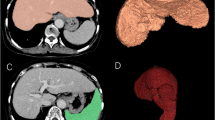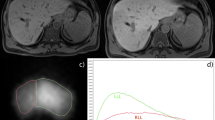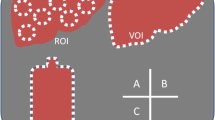Abstract
To evaluate the clinical utility of a new method with dynamic single photon emission computed tomography (SPECT) and scatter and attenuation compensation to estimate both total and regional liver function quantitatively. Five controls, 20 patients with chronic liver disease, and 2 patients with Budd-Chiari syndrome were studied. Dynamic liver SPECT data were acquired during 20 minutes after injection of Technetium (Tc)-99m diethylenetriaminepentaacetic acid (DTPA) galactosyl human serum albumin (GSA) with scatter and attenuation compensation. The binding rate constant of Tc-99m GSA, (Ku) was derived quantitatively from the Patlak plot based on kinetic models for GSA receptor binding. The mean Ku was obtained by dividing the Ku value (total Ku) by the liver volume. Both total and mean Ku were significantly lower in patients with chronic liver disease than in controls (302±112 vs. 523±78ml/min; p<0.001, 0.26±0.11 vs. 0.43±0.03 ml/min/cm3; p<0.001). In the patient group, both total and mean Ku were significantly correlated with the results of conventional liver function tests and the histological severity of chronic liver disease. In 2 patients with Budd-Chiari syndrome, the mean Ku was lower in the right lobe, where the hepatic veins were occluded, than in the left lobe, where draining veins were patent. In conclusion, this method is a reliable diagnostic technique for estimating total and regional liver function.
Similar content being viewed by others
References
Morell AG, Irvine RA, Stemlieb I, Scheinberg IH, Ashwell G. Physical and chemical studies on ceruloplasmin. V. Metabolic studies on sialic acid-free ceruloplasminin vivo.J Biol Chem 1968; 243: 155–159.
Aschwell G, Steer CJ. Hepatic recognition and catabolism of serum glycoproteins.JAMA 1981; 246: 2358–2364.
Stockert RJ, Morell AG. Hepatic binding protein. The galactose-specific receptor of mammalian hepatocytes.Hepatology 1983; 3: 750–757.
Krohn KA, Vera DR, Stadalnik RC. A complementary radiopharmaceutical model for quantitating hepatic-binding protein receptors. InReceptor-Binding Radiotracers II, Eckelman WC, Colombetti LG (eds), Boca Raton, CRC Press, 1982; 41–59.
Vera DR Krohn KA, Stadalnik RC, Scheibe PO. Tc-99m-galactosyl-neoglycoalbumin:In vivo characterization of receptor-mediated binding to hepatocytes.Radiology 1984; 151: 191–196.
Vera DR, Stadalnik RC, Trudeau WL, Scheibe PO, Krohn KA. Measurement of receptor concentration and forward-binding rate, constant via radiopharmacokinetic modeling of technetium-99m-galactosyl-neoglycoalbumin.J Nucl Med 1991; 32: 1169–1176.
Kudo M. Asialoglycoprotein.Kan tan sui 1994; 29: 673–681.
Stadalnik RC, Vera DR, Krohn KA. Receptor-binding radiopharmaceuticals: Experimental and clinical aspects. InNuclear Medicine Annual 1986, Freeman LM, Weissmann HS (eds), New York: Raven Press, 1986: 105–139.
Hwang EH.99mTc-GSA dynamic SPECT for mean hepatic functional reserve estimation: assessment of quantification.KAKU IGAKU (Jpn J Nucl Med) 1999; 36: 315–322.
Fujimori K, Shounai T, Koito K, Yoshida S, Takeda M, Yama N, et al. Estimation of99mTc-GSA receptor amount by non-linear 3-compartment model: ligand-receptor binding model without blood sampling.KAKU IGAKU (Jpn J Nucl Med) 1999; 36: 753–760.
Kudo M, Todo A, Ikekubo K, Hino M. Receptor index via hepatic asialoglycoprotein receptor imaging: correlation with chronic hepatocellular damage.Am J Gastroenterol 1992; 87: 865–870.
Kawa SHK, Tanaka Y. A quantitative model of technetium-99m-DTPA-galactosyl-HSA for assessment of hepatic binding protein.J Nucl Med 1991; 32: 2233–2240.
Shuke N, Aburano T, Nakajima K, Yokoyama K, Sun BF, Matsuda H, et al. The utility of quantitative99mTc-GSA liver scintigraphy in the evaluation of hepatic functional reserve: comparison with99mTc-PMT and99mTc-Sn colloid.KAKU IGAKU (Jpn J Nucl Med) 1991; 29: 573–584.
Ichihara T, Maeda H, Yamakado K, Motomura N, Matsumura K, Takeda K, et al. Quantitative analysis of scatter-and attenuation-compensated dynamic single-photon emission tomography for functional hepatic imaging with a receptor-binding radiopharmaceutical.Eur J Nucl Med 1997; 24: 59–67.
Rutland MD. A single injection technique for subtraction of blood background in I-131-hippuran renograms.Br J Radiol 1979; 52: 134–137.
Patlak CS, Blasberg RG, Fenstermacher JD. Graphical evaluation of blood-to-brain transfer constants from multiple-time uptake data.J Cereb Blood Flow Metab 1983; 3: 1–7.
Shinohara H, Niio Y, Hasebe S, Matsuoka S, Obuchi M, Higashi TS, et al. Quantitative analysis of99mTc-GSA liver scintigraphy with graphical plot method.Nippon Igaku Hoshasen Gakkai Zasshi 1996; 56 (4): 208–214.
Ichihara T, Ogawa K, Motomura N, Kubo A, Hashimoto S. Compton-scatter compensation using the triple energy window method for single and dual isotope SPECT.J Nucl Med 1993; 34: 2216–2221.
Ichihara T, Motomura N, Hasegawa H, Ogawa K, Hashimoto J, Kubo A. Improved transmission tomography using flood source and TEW scatter correction for attenuation compensation.J Nucl Med 1995; 36: 166.
Hashimoto J, Sammiya T, Ogasawara K, Kubo A, Ogawa K, Ichihara T, et al. Scatter and attenuation correction for quantitative myocardial SPECT using transmission measurement with a sheet line source.KAKU IGAKU (Jpn J Nucl Med) 1996; 33: 1015–1019.
Ogawa K, Takagi Y, Kubo A, Hashimoto S, Sanmiya T, Okano Y, et al. An attenuation correction method of single photon emission computed tomography using gamma ray transmission CT.Jpn J Nucl Med 1985; 22: 477–490.
Yamanaka N, Okamoto E, Kawamura E, Kato T, Oriyama T, Fujimoto J, et al. Dynamics of normal and injured liver regeneration after hepatectomy as assessed on the basis of computed tomography and liver function.Hepatology 1993; 18: 79–85.
Chen M, Hwang T, Hung C. Human liver regeneration after major hepatectomy. A study of liver volume by computed tomography.Ann Surg 1991; 213: 227–229.
Shimada M, Matsumata T, Maeda T, Itasaka H, Suehiro T, Sugimachi K. Hepatic regeneration following right lobectomy: estimation of regenerative capacity.Surg Today 1994; 24: 44–48.
Zeman RK, Fox SH, Silverman PM, Davros WJ, Carter LM, Griego D, et al. Helical (spiral) CT of the abdomen.AJR 1993; 160: 719–725.
Pugh RN, Murray-Lyon IM, Dawson JL, Pietroni MC, Williams R. Transection of the oesophagus for bleeding oesophageal varices.Br J Surg 1973; 60: 646–649.
Knodell RG, Ishak KG, Black WC, Chen TS, Craig R, Kaplowitz N, et al. Formulation and application of a numerical scoring system for assessing histological activity in asymptomatic chronic active hepatitis.Hepatology 1981; 5: 431–435.
Ha-Kawa SK, Tanaka Y. A quantitative model of technetium-99m-DTPA-galactosyl-HSA for the assessment of hepatic blood flow and hepatic binding receptor.J Nucl Med 1991; 32: 2233–2240.
Wood AJJ, Villeneuve JP, Branch RA, Rogers LW, Shand DJ. Intact hepatocyte theory of impaired drug metabolism in experimental cirrhosis in the rat.Gastroenterology 1979; 76: 1358–1362.
Gartner U, Stockert RJ, Morell AG, Wolkoff AW. Modulation of the transport of bilirubin and asialoorosomucoid during liver regeneration.Hepatology 1981; 1: 99–106.
Kawasaki S, Imamura H, Bandai Y, Sanjo K, Idezuki Y. Direct evidence for intact hepatocyte theory in cirrhotic patients.Gastroenterology 1991; 100: A759.
Murphy FB, McDermott WV, Sone MD, Bothe A, Trey C. Budd-Chiari syndrome: historical and clinical review with analysis of surgical corrective procedures.Am J Surg 1984; 147: 463–467.
Lisbona R, Katz S, Mishkin S. Serial radionuclide liver imaging in Budd-Chiari syndrome.J Can Assoc Radiol 1981; 32: 175–177.
Author information
Authors and Affiliations
Corresponding author
Rights and permissions
About this article
Cite this article
Yamakado, K., Matsumura, K., Takashiba, Y. et al. Binding rate constant of Tc-99m DTPA galactosyl human serum albumin measured by quantitative dynamic SPECT —Clinical evaluation as a total and regional liver function test—. Ann Nucl Med 15, 191–198 (2001). https://doi.org/10.1007/BF02987830
Received:
Accepted:
Issue Date:
DOI: https://doi.org/10.1007/BF02987830




